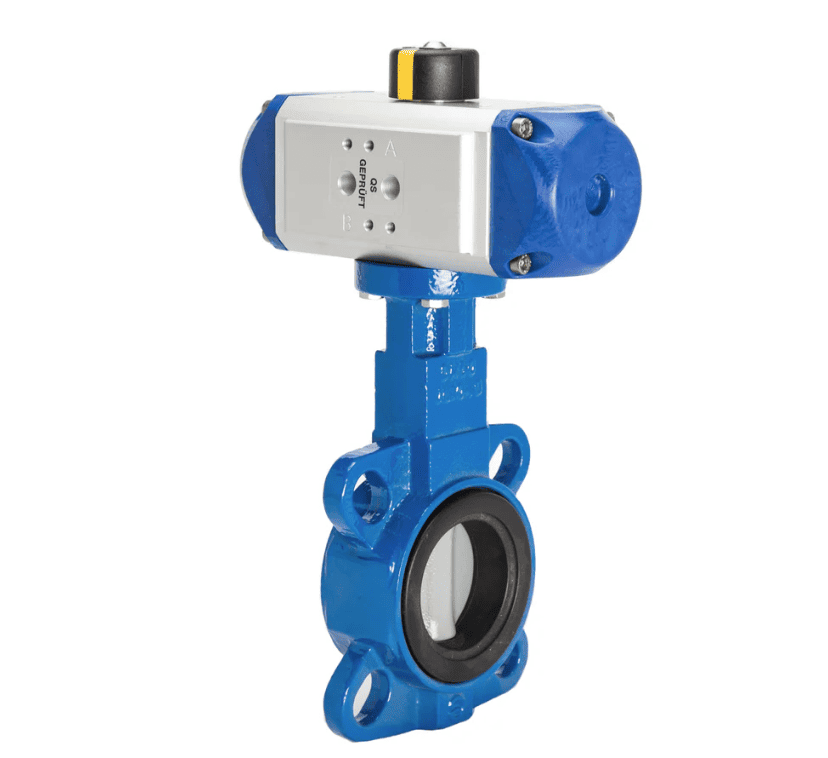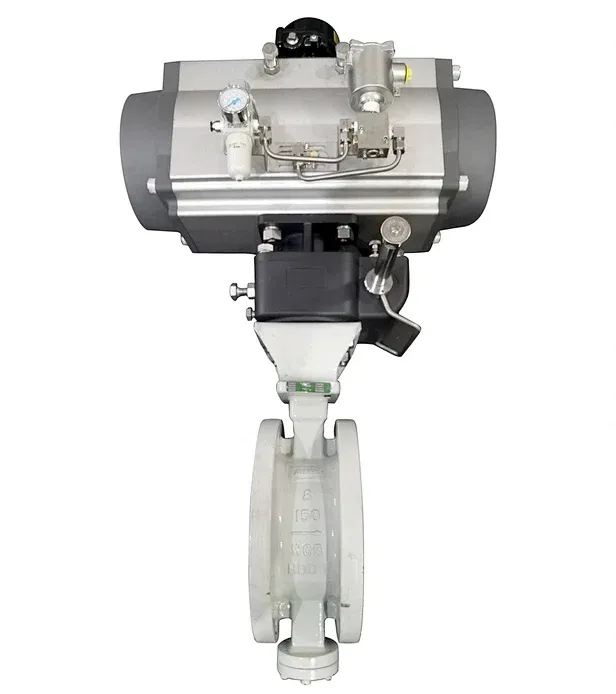
In the industrial world, precision, efficiency, and reliability are critical factors in fluid control. Whether in water treatment plants, chemical processing facilities, HVAC systems, or food production lines, valves play a central role in regulating the flow of liquids, gases, or slurries. Among the many valve types, the pneumatic butterfly valve has earned a solid reputation for its simplicity, rapid operation, and versatility.
Pneumatic butterfly valves are widely used as shut-off devices, but they can also be designed for throttling or regulating purposes. Their combination of a lightweight structure, quick actuation, and adaptable design has made them an attractive choice for industries seeking both automation and durability.
In this article, we will explore what pneumatic butterfly valves are, how they work, their advantages, different types, operating principles, and best maintenance practices—giving you a complete guide to understanding and using them effectively.
At its core, a pneumatic butterfly valve is a fusion of two components:
The Butterfly Valve – This features a disc (the “butterfly plate”) mounted on a shaft that rotates to allow, restrict, or block the passage of media through the pipeline.
The Pneumatic Actuator – Powered by compressed air, this device automatically rotates the shaft, eliminating the need for manual operation.
When installed in a pipeline, the pneumatic actuator uses air pressure to turn the butterfly plate 90 degrees, shifting it from fully open to fully closed, or vice versa. The same design can also hold the disc in partially open positions for controlled regulation of flow.
While cut-off service is the most common application, pneumatic butterfly valves can be customized for precise flow regulation, ventilation systems, or even high-cycle, high-pressure industrial tasks.

The pneumatic butterfly valve offers a range of benefits that make it stand out from other valve types:
Compared to bulkier valves like gate or globe valves, butterfly valves have a smaller footprint and lower weight, making them easier to install and integrate into space-limited environments.
These valves can be installed in almost any orientation and require minimal effort for assembly or removal, reducing downtime during servicing.
A simple 90-degree rotation—powered by a pneumatic actuator—means the valve can open or close within seconds, allowing for rapid response in emergency shutdowns or process adjustments.
The design minimizes resistance, so less force is needed to operate the valve. This not only reduces actuator wear but also makes manual backup operation easier when required.
Pneumatic butterfly valves provide a nearly linear flow characteristic, offering predictable and controllable fluid dynamics—critical for process efficiency.
By eliminating pins in the stem connection, the valve removes potential internal leakage points, improving sealing integrity.
With a spherical valve body design, sealing is improved, and wear is minimized. Many models can perform over 50,000 open-close cycles without leakage.
Seats and seals can be replaced without removing the valve from the pipeline, offering cost savings and extending service life.
Discs can be coated with nylon, PTFE, or other protective materials for enhanced corrosion and chemical resistance.
Flanged, wafer, lug, or clamp-style connections can be selected to match specific piping systems.
While pneumatic actuation is standard, these valves can also be fitted with manual levers or electric actuators for different control preferences.
Choosing the right type of pneumatic butterfly valve depends heavily on the intended application and operating environment. Common types include:
Pneumatic Wafer Butterfly Valves – Designed to fit between flanges without additional bolts, making them lightweight and cost-efficient.
Telescopic Butterfly Valves – Feature adjustable lengths for installations where pipe distances vary.
Ventilation Butterfly Valves – Optimized for handling air or low-pressure gases in ventilation or HVAC systems.
Regulating Butterfly Valves – Specifically designed for precise flow modulation rather than full open/close service.
Each type serves a distinct purpose, so selection should be based on media type, pressure level, temperature range, and flow requirements.
The pneumatic butterfly valve operates on a simple yet highly efficient mechanism, making it an ideal choice for automated fluid control systems. At the core of its operation is the use of compressed air as the driving force.
The process begins when compressed air is supplied to the pneumatic actuator through a control port. This air pressure is carefully regulated to match the specific operational requirements of the system.
Inside the actuator, the incoming air pressure acts on pistons or diaphragms, converting the linear force of the air into rotary motion. This mechanical transformation drives the valve stem, which is connected directly to the butterfly plate.
As the stem rotates, the butterfly disc inside the valve body turns up to 90 degrees. In the fully open position (0°), the disc aligns parallel with the flow direction, allowing maximum passage of fluid or gas. In the fully closed position (90°), the disc sits perpendicular to the flow, effectively sealing the passage and stopping movement of the medium.
Between these two extremes, the disc can be positioned at various angles for throttling control, allowing operators to precisely regulate flow rates.
This quarter-turn operation delivers fast, reliable, and repeatable performance, with pneumatic actuation enabling quick response times—making pneumatic butterfly valves particularly well-suited for applications requiring rapid shut-off or adjustment.
Uses air pressure for one movement (open or close) and a mechanical spring for the reverse movement.
Ensures the valve returns to a safe default position in case of power or air supply loss.
Common in fail-safe systems.
Uses air pressure for both opening and closing.
Provides precise bidirectional control without a spring mechanism.
Suitable for applications where fail-safe positioning is not essential.
A pneumatic butterfly valve typically includes:
Valve Body – The housing that contains the disc and seat, often made from stainless steel, ductile iron, or bronze.
Butterfly Disc – Controls the flow; can be bare metal or coated for protection.
Stem/Shaft – Connects the actuator to the disc.
Seat/Seal – Provides tight shutoff, usually made from elastomers or metal alloys.
Pneumatic Actuator – The driving mechanism that uses compressed air to rotate the shaft.
Proper maintenance ensures long service life and safe operation:
Confirm that temperature, pressure, and media compatibility meet the valve’s specifications.
Avoid letting water, oil, or debris enter the actuator or valve, as these can shorten lifespan.
Periodically lubricate moving parts and clean external surfaces to prevent dust buildup.
Follow manufacturer guidelines, ensuring proper alignment and avoiding overtightening.
Use the valve only in fully open or fully closed positions unless it’s specifically designed for regulation.
Avoid partially open positions that could erode sealing surfaces.
Store in a dry, well-ventilated area with both ends sealed to prevent damage from moisture or dirt.
Protect sealing surfaces from scratches or impact damage.
Pneumatic butterfly valves are widely used in:
Water Treatment Plants – For isolating flow or regulating water distribution.
Chemical Processing – To control corrosive fluids with PTFE-coated discs.
HVAC Systems – For air handling and chilled water regulation.
Food and Beverage – With sanitary-grade stainless steel and seals for hygienic processing.
Oil and Gas – In pipelines requiring fast, reliable shutoff under hazardous conditions.
The pneumatic butterfly valve is a perfect example of how simple mechanical design can be combined with automation technology to deliver fast, reliable, and adaptable flow control. With their compact structure, rapid actuation, and low maintenance needs, these valves offer an ideal solution for industries seeking efficient and cost-effective control systems.
By understanding their design, advantages, types, working principle, and maintenance requirements, operators and engineers can select the right pneumatic butterfly valve for their needs—ensuring smooth operation and extended service life.